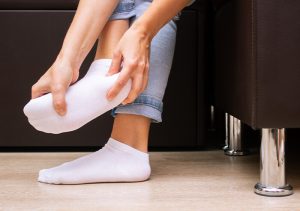Plantar fasciitis is a common condition that affects the heel and bottom of the foot and can cause pain in the heel or arch of the foot, especially in the morning or after prolonged standing or walking. Without proper treatment, the pain can become chronic and significantly impact a person’s quality of life. At Twin Boro Physical Therapy, we offer a comprehensive evaluation to determine the root cause of your plantar fasciitis and develop a treatment plan using a combination of manual therapy techniques, therapeutic exercises, and modalities to relieve plantar fasciitis pain.
What Causes Plantar Fasciitis Pain?
 The plantar fascia is a thick band of tissue that connects the heel bone to the toes and supports the arch of the foot. When this tissue becomes inflamed or damaged, it causes a stabbing pain sensation in the heel or arch of the foot. One of the most common causes of the development of plantar fasciitis is overuse or repetitive strain on the plantar fascia, such as running or walking long distances, standing for extended periods, or wearing shoes with poor arch support. Other risk factors include:
The plantar fascia is a thick band of tissue that connects the heel bone to the toes and supports the arch of the foot. When this tissue becomes inflamed or damaged, it causes a stabbing pain sensation in the heel or arch of the foot. One of the most common causes of the development of plantar fasciitis is overuse or repetitive strain on the plantar fascia, such as running or walking long distances, standing for extended periods, or wearing shoes with poor arch support. Other risk factors include:
- Age.
- Being overweight.
- Having flat feet or high arches.
- Medical conditions, such as arthritis or diabetes.
Fortunately, physical therapy can effectively relieve plantar fasciitis pain and help patients return to normal activities.
Manual Therapy Techniques for Plantar Fasciitis
One standard physical therapy treatment for plantar fasciitis is manual therapy techniques such as soft tissue mobilization or joint mobilization. These techniques involve using hands-on pressure and movement to stretch and loosen tight muscles and connective tissue in the foot and lower leg, which can help improve range of motion and reduce pain.
Strengthening and Stretching Exercises for Plantar Fasciitis
Another important aspect of physical therapy for plantar fasciitis is strengthening exercises for the foot and ankle. Strengthening exercises can help improve the stability and support of the foot and reduce the strain on the plantar fascia. These exercises may include calf raises, toe curls, or resistance band exercises to improve ankle strength and flexibility.
Stretching exercises are also a key component of physical therapy for plantar fasciitis. Stretching the calf muscles, Achilles tendon, and plantar fascia itself can help reduce pain and improve flexibility. Your physical therapist may recommend specific stretches or special techniques, such as a night splint or orthotics, to help stretch the plantar fascia and reduce pain.
Lifestyle Changes for Plantar Fasciitis
In addition to these exercises and techniques, your physical therapist may also recommend modifications to your daily routine to reduce the strain on the plantar fascia. Instruction may include:
- Wearing shoes with proper arch support to help distribute weight evenly and provide stability to the foot.
- Using cushioned insoles or orthotics to provide additional support, cushioning, and shock absorption for the feet. These inserts can help reduce pressure on the plantar fascia and provide relief from pain.
- Avoiding high-impact activities such as running or jumping. Low-impact exercises like swimming, cycling, or using an elliptical machine can be alternative options to maintain cardiovascular fitness without aggravating the condition.
Get Started Today!
At Twin Boro Physical Therapy, our experienced therapists understand the challenges and frustrations of living with plantar fasciitis pain. With a personalized physical therapy treatment plan, your skilled team of physical therapists is here every step of the way to help you achieve lasting relief from plantar fasciitis pain. Contact us today at 732.554.0775 or visit our appointment scheduling page at https://twinboro.com/schedule-appointment.html.

